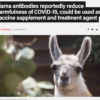For the past seven years Triple J Farms has been studying the use of the measurement of llama IgG in improving the management and breeding of llamas. This paper is preliminary data on monitoring the IgG concentrations in llama colostrum over several years and its relationship to passive transfer and the health of newborn crias.
IgG is an immunoglobulin found in many species that provides a first line of defense against viruses and other infectious agents that invade the blood. IgG is consumed and is not the same concentration at 30 days as day one. In man, IgG is passed through the placenta into the fetus with babies having IgG at first breath. In horses, cattle, sheep and camelids IgG is not passed through the placenta and is given to the newborn only when it suckles colostrum. This is called passive transfer. IgG levels in these newborns are directly dependent on the amount of colostrum they suckle, the titer or strength of the colostrum and finally the time at which they begin to suckle. When a baby does not ingest enough colostrum and the IgG level is below normal this is called failure of passive transfer (FPT). Studies on foals have shown that FPT occurs in 2.5 to 17% of all newborns. In llamas, we have observed partial FPT seems to average around 10% of newborns with reasons for FPT ranging from nervous first time dams, initial poor colostrum available, dumb babies, premature babies, and so on.
IgG in the average baby on 230 samples at 24 hours has averaged 1657 mg/dl. The numbers in the average ranged from a low of 200 mg/dl to a high of 4500 mg/dl. The IgG was measured with a Triple J Radial Immunodiffusion Test. The numbers discussed in this paper are pertinent only if you are using the Triple J test kit. Colostrum is diluted to 1 to 10 with saline and transferred to the plate in the same manner as serum is measured.
Total proteins have also been used as a method of determining passive transfer, however, they do not measure IgG alone. If your baby llama is dehydrated or your other proteins such as fibrinogen are elevated you obtain a reading that does not accurately reflect the babies passive transfer.
We have used IgG tests in the baby to determine that adequate passive transfer has occurred. We noticed over the years that babies from the same mother had relatively consistent passive transfer titers. This caused us to pay more attention to the dams colostrum titer which on 292 samples has averaged 16,315 mg/dl on presuckle samples with a low of 2000 mg/dl to a high of 35,000 mg/dl. The average colostrum titer seemed to average ten times the average 24 hour passive transfer titer. We decided that we would use the IgG tests to aid our selections in improving our herd. We would choose bloodlines in our male studs that had dams with a history of good passive transfer and average to high colostrum titers.
These ideas are all taken from management ideas with sheep and cattle. We used the IgG tests to give us a number or a physical observation of the llamas ability to produce high titered IgG colostrum. We keep a single sheet of paper in a New Baby Record Book for the current year on each pregnant female that lists the last 5 year birth weights, passive transfer titers, colostrum titers and other relevant data. If a dam is in labor, anyone who is on the farm can refer to this paper and know what problem if any might occur with this particular female.
In reporting the numbers, we have found to date that we cannot draw any firm conclusions in less than 8 to 10 years. We have noticed first time mothers have slightly lower than average colostrum levels that increase on the second or third year. We have found the females are relatively consistent in colostrum production year after year within plus or minus 2000 mg/dl. We cannot account for some females with good colostrum titers most years and bad titers on one or two years. Causes could possibly be colostrum leakage before birth. Values similar to these have been seen by Dr. Bravo at the La Raya Research station in Peru in his studies using these same tests. His information is more thorough in that he measures colostrum and blood levels in the dam daily, 20 days before parturition and 60 days after. The babies were also monitored before suckling and up to 60 days after. This data will hopefully be released soon. Dams with colostrum levels below 7000 mg/dl almost always have poor passive transfer in their babies. Conversely, dams with above average colostrum titers do not always have good passive transfer because they may not have a lot of colostrum. Knowing that a dam has a certain colostrum concentration does not guarantee good passive transfer.
One of our goals that we wish to accomplish with this ongoing study is to be able to determine if a male from a good colostrum and milk producer will improve the female offspring from a dam with below average milk and colostrum production.
The table is shown to give people an idea on the trends in IgG levels in colostrum and passive transfer that we have seen on individual dams. We have published the data at this time to show normals on our particular test. Some new llama breeders are being told in different parts of the country that colostrum titers of 6500 mg/dl and IgG titers of 300 mg/dl are normal, this may be so on other company's tests. Our tests which are used by approximately 200 veterinarians and 10 universities across the country have normal values as discussed in this paper. If a breeder wants to use monitoring of IgG to determine passive transfer and measure colostrum value, it is extremely important that they know published normal values on the test being used for their animals.





